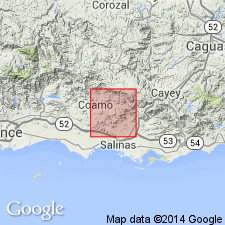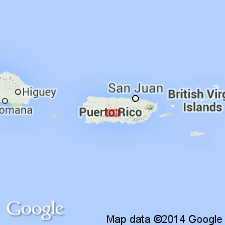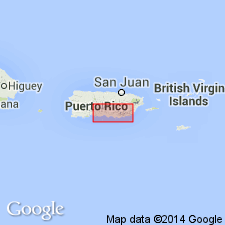
- Usage in publication:
-
- Santa Ana Limestone Member*
- Modifications:
-
- Revised
Summary:
The Santa Ana Limestone Member of the Coamo Formation, here named, consists of light-gray limestone composed largely of shell fragments in a matrix of clayey to tuffaceous limestone. Overlies the San Diego Lapilli Tuff Member and underlies a southward-thinning wedge of tuff breccia in the Coamo. Age is Late Cretaceous.
Source: GNU records (USGS DDS-6; Reston GNULEX).

- Usage in publication:
-
- Santa Ana Limestone Member*
- Modifications:
-
- Revised
- Areal extent
Summary:
In west-central PR the Coamo Formation is restricted to the massive volcanic rocks, excluding the bedded units (San Diego Lapilli Tuff Member, Santa Ana Limestone Member, and unnamed conglomerate and sandstone and siltstone units) below the massive volcanic units. The conformably underlying Maravillas Formation has been defined to include the sequence below the restricted Coamo and limestone blocks and lenses in the Maravillas may be correlative with the Santa Ana Member and lapilli tuff and tuff lenses in the Jayuya quadrangle may be correlative with the San Diego Member. In the Jayuya quadrangle, the Coamo consists of coarse-grained tuff, lapilli tuff, and fine-grained volcanic breccia. Upper contact of the Coamo is removed by erosion. Thickness is 300 m. Age is Campanian to Maestrichtian based on fossils.
Source: GNU records (USGS DDS-6; Reston GNULEX).

- Usage in publication:
-
- Santa Ana Limestone Member*
- Modifications:
-
- Revised
Summary:
In the Coamo area the Maravillas Formation includes the basal Sabana Hoyos Limestone Member, reassigned from the underlying Cariblanco Formation, the San Diego Member, here redefined from Tuff Member to Member, the Santa Ana Limestone Member, reassigned to the Maravillas Formation from the overlying Coamo Formation, and younger unnamed map units of mudstone, pyroclastic rocks, limestone, and conglomerate,
Source: GNU records (USGS DDS-6; Reston GNULEX).
For more information, please contact Nancy Stamm, Geologic Names Committee Secretary.
Asterisk (*) indicates published by U.S. Geological Survey authors.
"No current usage" (†) implies that a name has been abandoned or has fallen into disuse. Former usage and, if known, replacement name given in parentheses ( ).
Slash (/) indicates name conflicts with nomenclatural guidelines (CSN, 1933; ACSN, 1961, 1970; NACSN, 1983, 2005, 2021). May be explained within brackets ([ ]).

